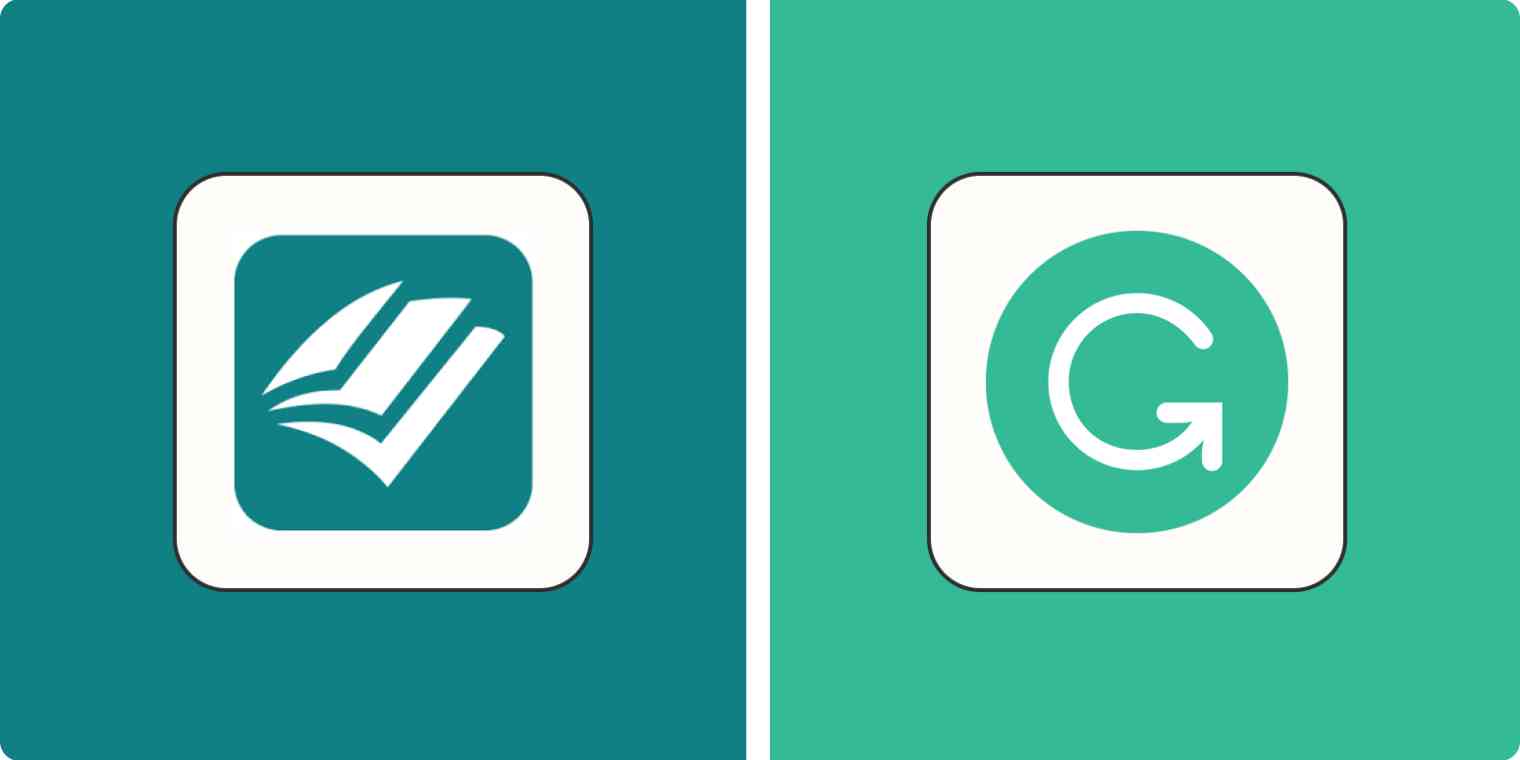Everyone's a writer in some shape or form. Whether sending a message, posting a social update, sharing your opinion, or publishing a novel, we communicate through writing. Often we don't think twice about how we write, which sometimes leads to miscommunication. But other times, we know that our writing needs to be spot on.
Aside from hiring an editor, you can use apps to check your spelling, grammar, and punctuation. And you can go even deeper with AI grammar checkers and rewording tools like Grammarly and ProWritingAid. These apps can also check your intent, tone, and style to ensure you deliver the right message.
I've tested and written about Grammarly and ProWritingAid previously. And although I've used Grammarly almost daily throughout my writing career, I was keen to see how the two apps fared in a direct comparison. So, for this article, I signed up and tested each platform. I spent time running various scenarios to see how they stacked up against each other. And here's my verdict.
Grammarly vs. ProWritingAid at a glance
Here's a quick comparison table to get you started, but keep reading for details about the various features and my experience using each app. Or you can scroll to the end for a quick summary of which AI grammar checker will be best for you.
| Grammarly | ProWritingAid |
|---|---|---|
Ease of use | ⭐⭐⭐⭐⭐ Less-cluttered interface to navigate | ⭐⭐⭐⭐ Overwhelming number of reports and menus |
Customization | ⭐⭐⭐⭐ Wide range of options to fit your writing preferences | ⭐⭐⭐⭐ Extensive customization options and style guides for different needs |
Analysis reports | ⭐⭐⭐ A basic PDF report | ⭐⭐⭐⭐⭐ 20+ in-depth online reports |
Generative AI | ⭐⭐⭐⭐ Lots of ways to rephrase or rewrite the highlighted text | ⭐⭐⭐ Suggests rewriting everything and only offers a few suggestions |
Integrations | ⭐⭐⭐⭐ Integrates with 500,000+ apps | ⭐⭐⭐ No mobile integration |
Pricing and support | ⭐⭐⭐⭐ More expensive, but not outrageous | ⭐⭐⭐⭐ Great pricing options, but plagiarism checker is extra |
A quick word about accuracy
Both of these apps are running on top of large language models (LLMs)—they're not trained identically, but the accuracy will be subjective no matter how you slice it. Here are a few examples highlighting the quirks in accuracy.
Both apps flag different unknown words or misspellings. For example, ProWritingAid flags "burndown" as a misspelling and suggests "burn-down" or "turndown" as a replacement:
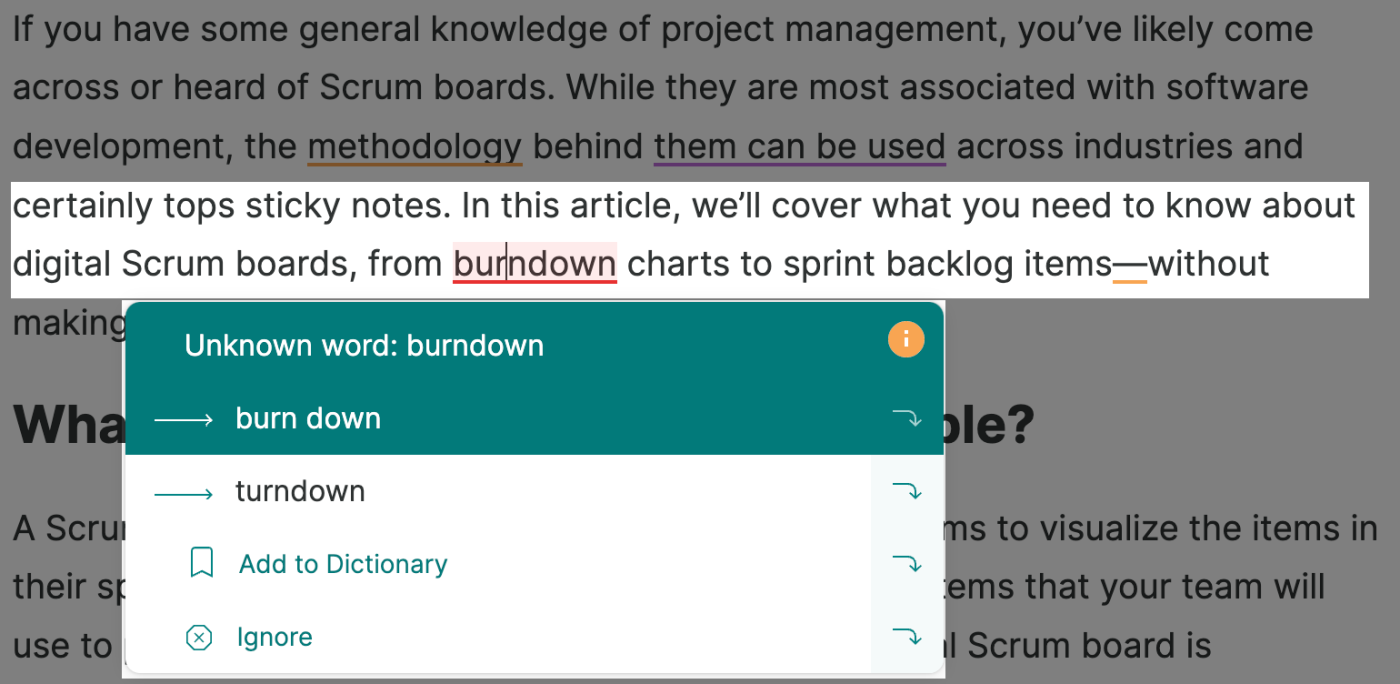
Grammarly, on the other hand, thinks it's spelled correctly:

(And I'd be inclined to agree.)
Sometimes, though, the apps agree. Take this sentence, for example: "Now that you know about Asana's work management features, you might be wondering what you should look for when choosing a work management tool." Both apps think it might be unclear and suggest changing "you might be wondering what you should" to "you might wonder what."
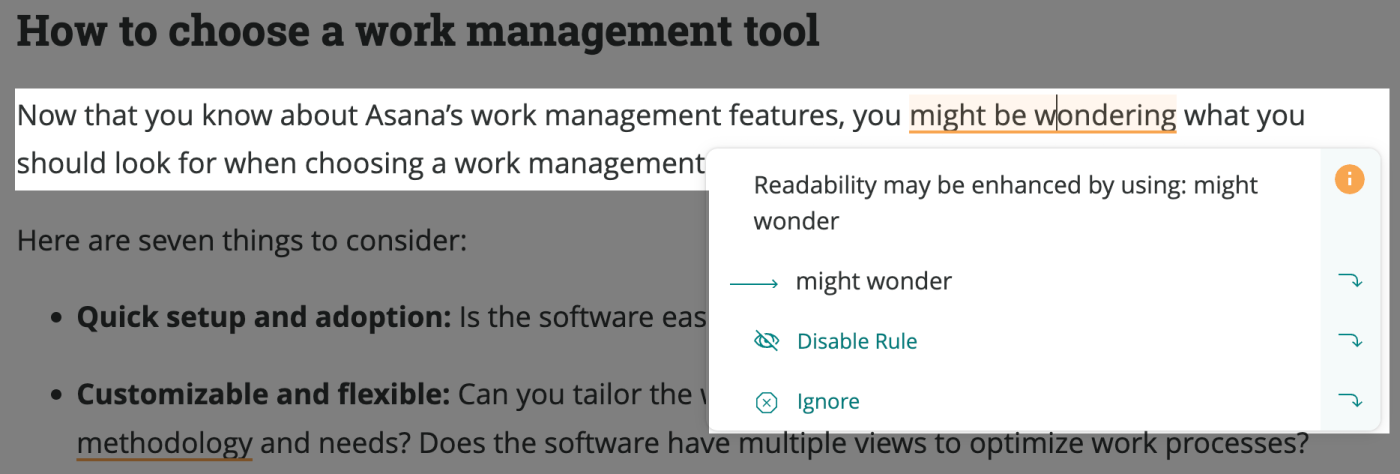

All this goes to show that, although these apps are great, you have to question and check anything that looks untoward. Don't go accepting every suggestion from either app.
And because it's subjective in any case, I'm going to focus on the features of the apps, not the accuracy of the suggestions.
Grammarly is slightly easier to use
Grammarly and ProWritingAid are available in various flavors, including desktop, mobile, web browsers, apps, and plugins. More on these later—for now, I'll focus on the web apps.
Here's Grammarly's editor.
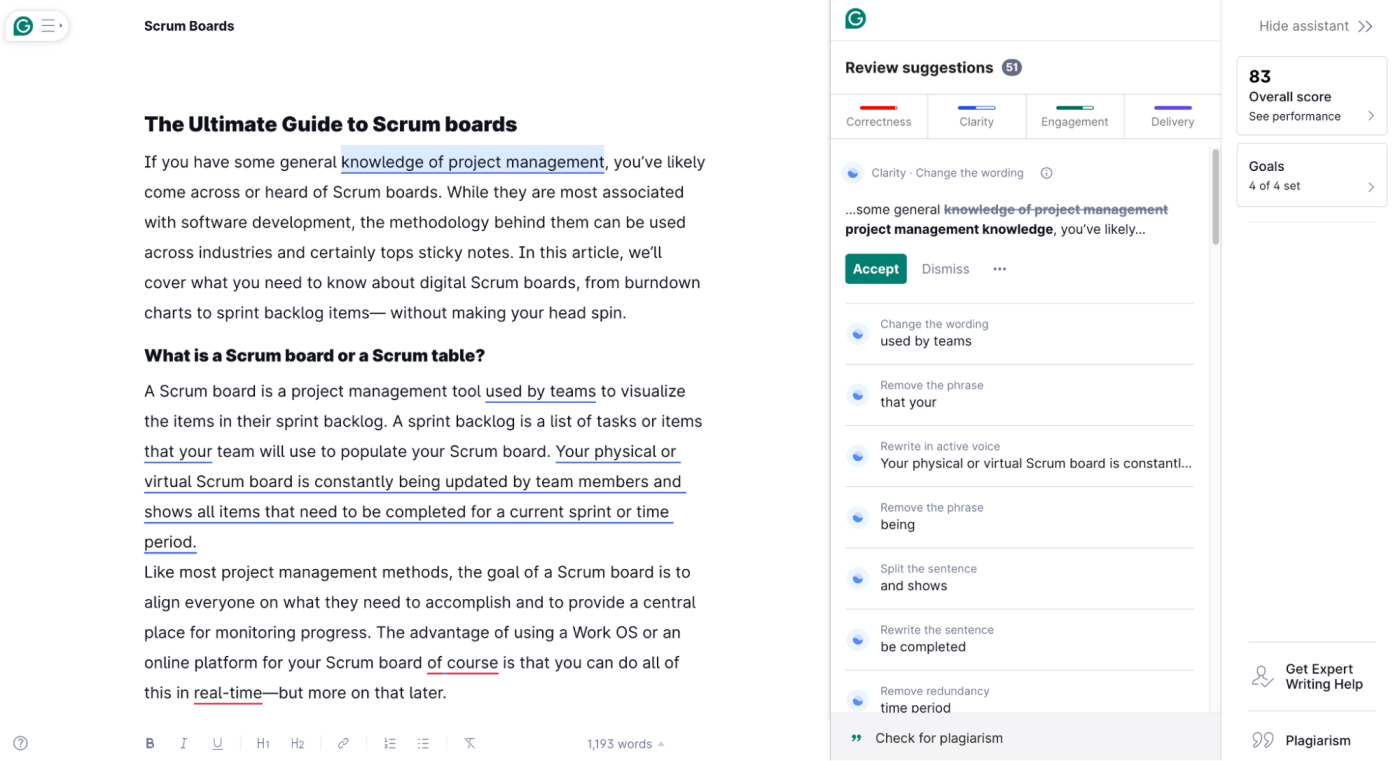
And here's ProWritingAid's editor.

In my opinion, Grammarly has a cleaner, less-cluttered interface (although you can hide the top and side menus in ProWritingAid). Both apps highlight errors in-line, and in terms of using and accepting suggestions, there's not much difference between the apps. You work through the document, and accept or ignore the recommendations.
One niggle with ProWritingAid: sometimes it freezes completely when renaming a file. And when I tried to print a Critique Report as a PDF, I just got the spinning wheel and had to abort the idea.

Grammarly, on the other hand, updates instantly.
So, overall, even though it's a subtle difference, I found Grammarly more stable and slightly easier to use than ProWritingAid.
Both apps offer extensive customization options
Grammarly and ProWritingAid both have loads of customization options, which is especially important in a business setting. You can add a personal dictionary, for example, and customize the editor settings to fit your writing preferences. There's an extensive range of options on both, including things like:
Use consistent capitalization
Use a consistent style of abbreviation
Avoid using very complex sentences
Avoid using the passive voice
Avoid using clutter words
In ProWringAid, you check the boxes and select the dropdown option, though it gives you a little more flexibility in terms of where the customizations are implemented. You can see in the screenshot below, for example, that the passive voice checker is turned off for documents categorized as academic papers.
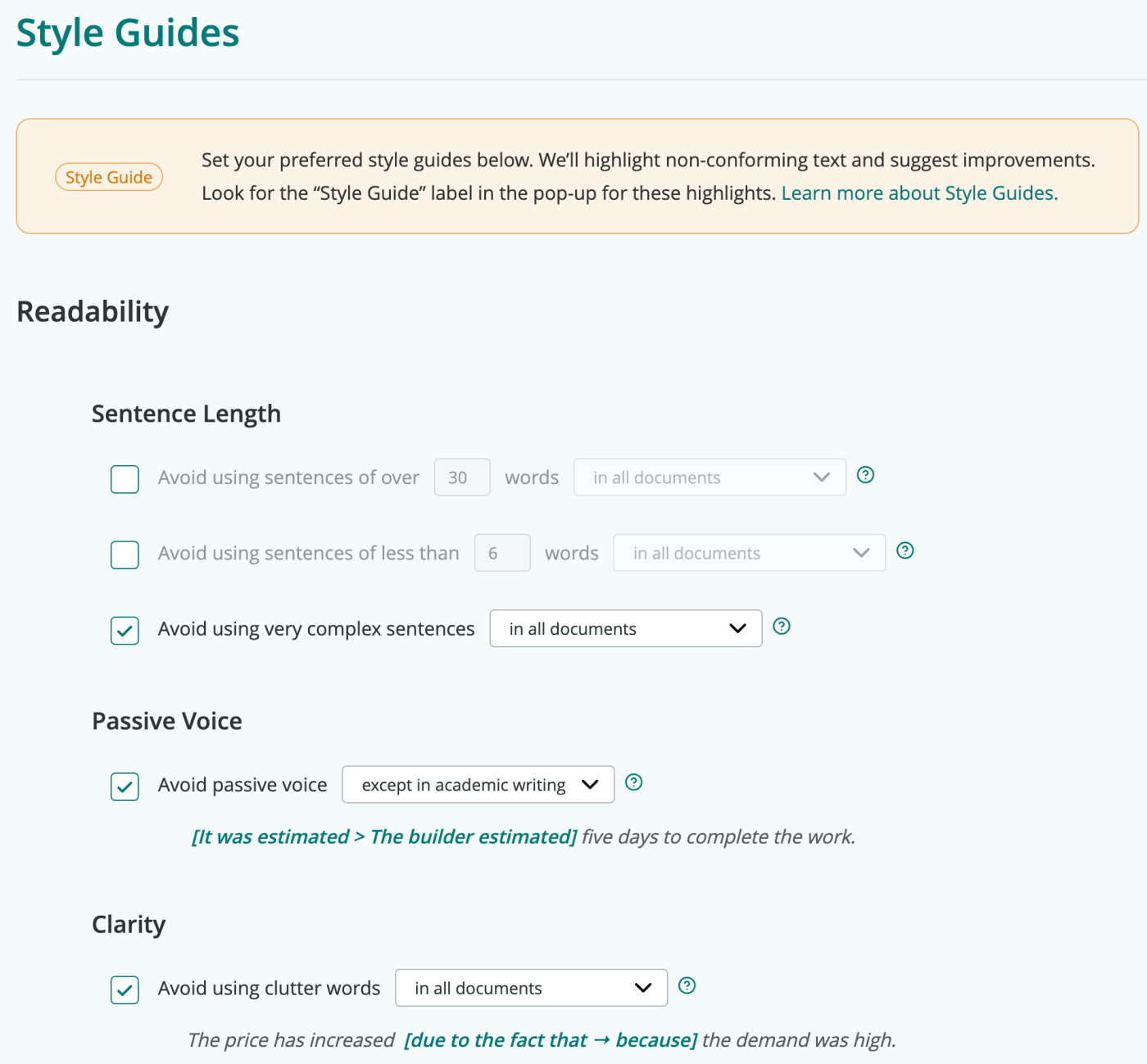
On Grammarly, you can apply broad-strokes goals to each article (more on that in a bit), but you toggle the settings on and off universally.
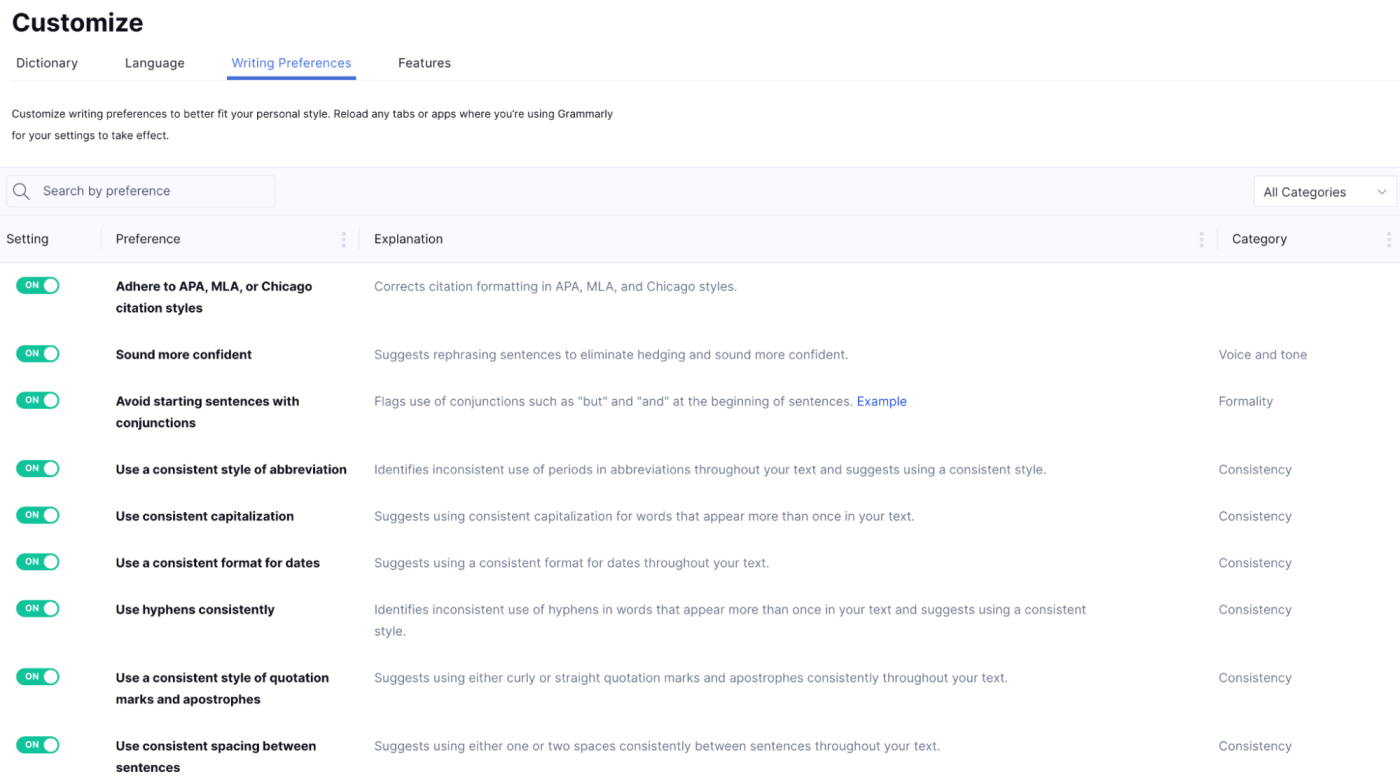
They also differ a bit in how they apply the rules. ProWritingAid seems more rigorous. For example, it flags this sentence as complex.

Whereas Grammarly doesn't, for the same sentence.

Again, just because the app suggests a sentence is complex, doesn't mean it is. The AI algorithms make their recommendations based on their vast training data. You should have a clearer idea of what your audience can handle—it's just that ProWritingAid seems to follow its rules more closely.
Back to those goals I mentioned: before you begin editing your work, both apps let you set goals for the piece, so the algorithms make valid suggestions. For instance, you wouldn't apply academic writing rules to your social media posts.
Grammarly offers four writing goals—domain, intent, audience, and formality—to tailor your writing suggestions, which you can set at the start of each piece.
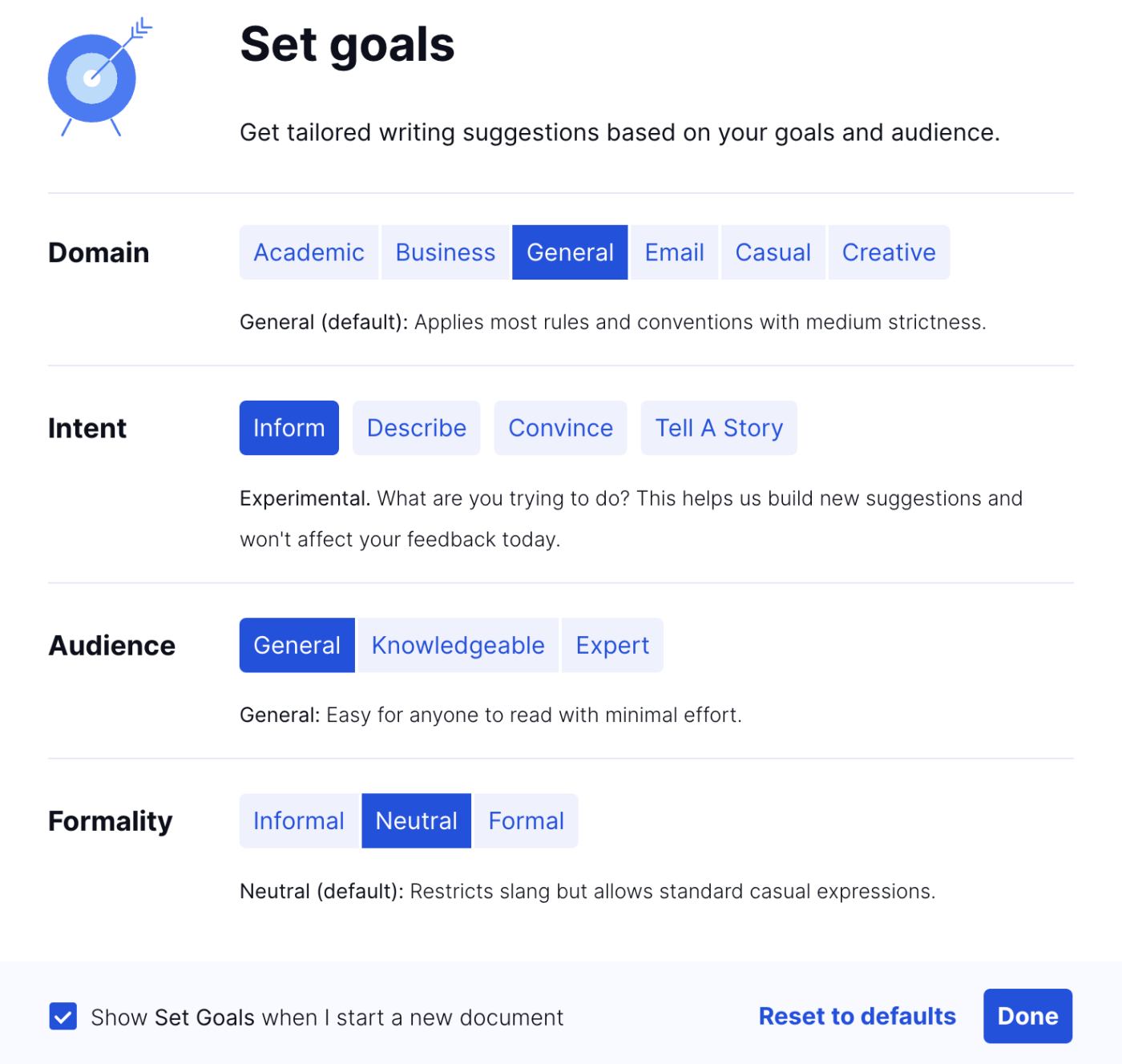
ProWritingAid has more refinement on the domain. For example, you can select general, long, or short web content (and there are more types of writing to choose from), but doesn't include the other goals.
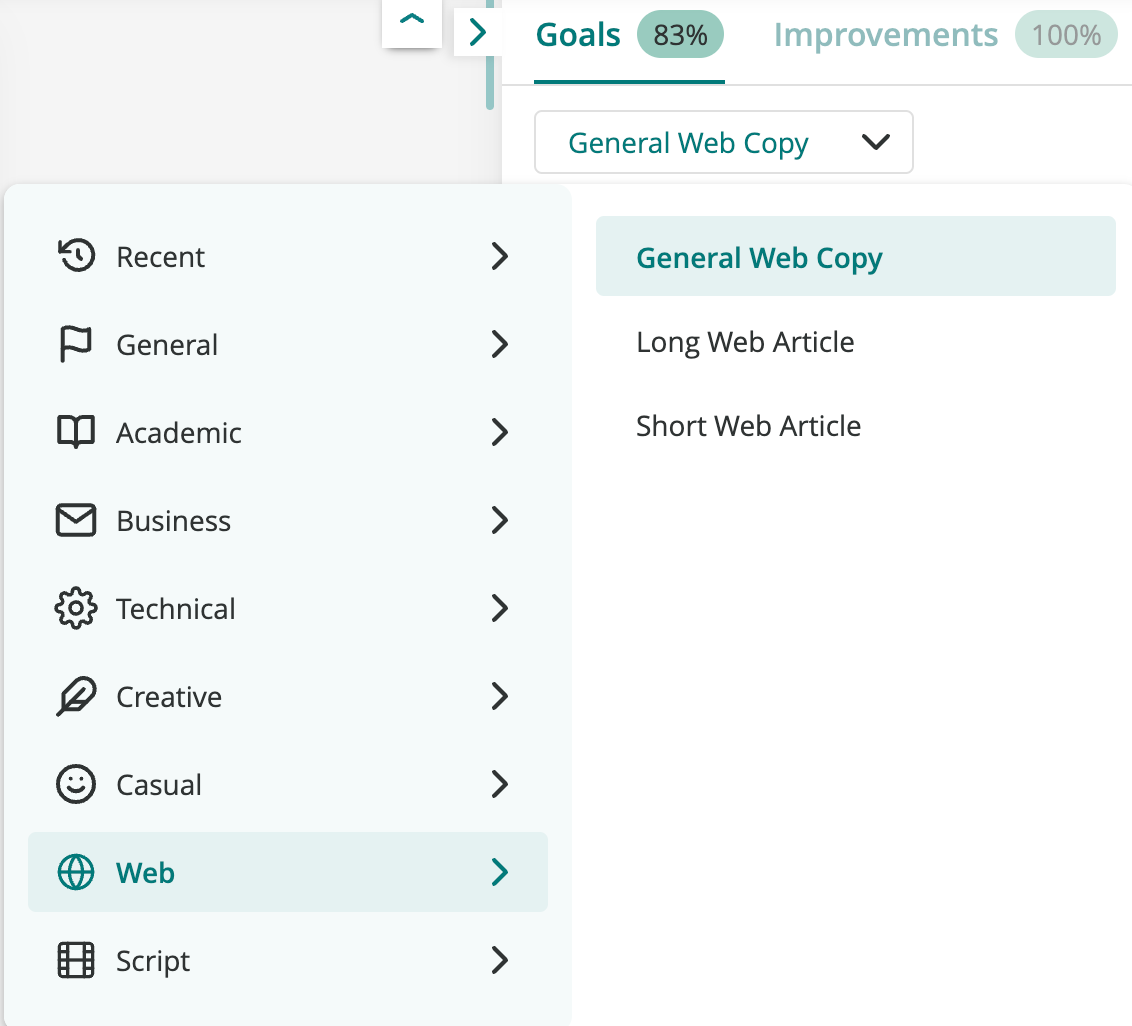
One isn't necessarily better than the other—it's just a matter of whether it offers what you're looking for as a writer.
ProWritingAid wins hands-down on analysis reports
Part of why ProWritingAid has a bit more of a learning curve is that it focuses heavily on reports covering grammar, style, readability, consistency, and plenty of other things.
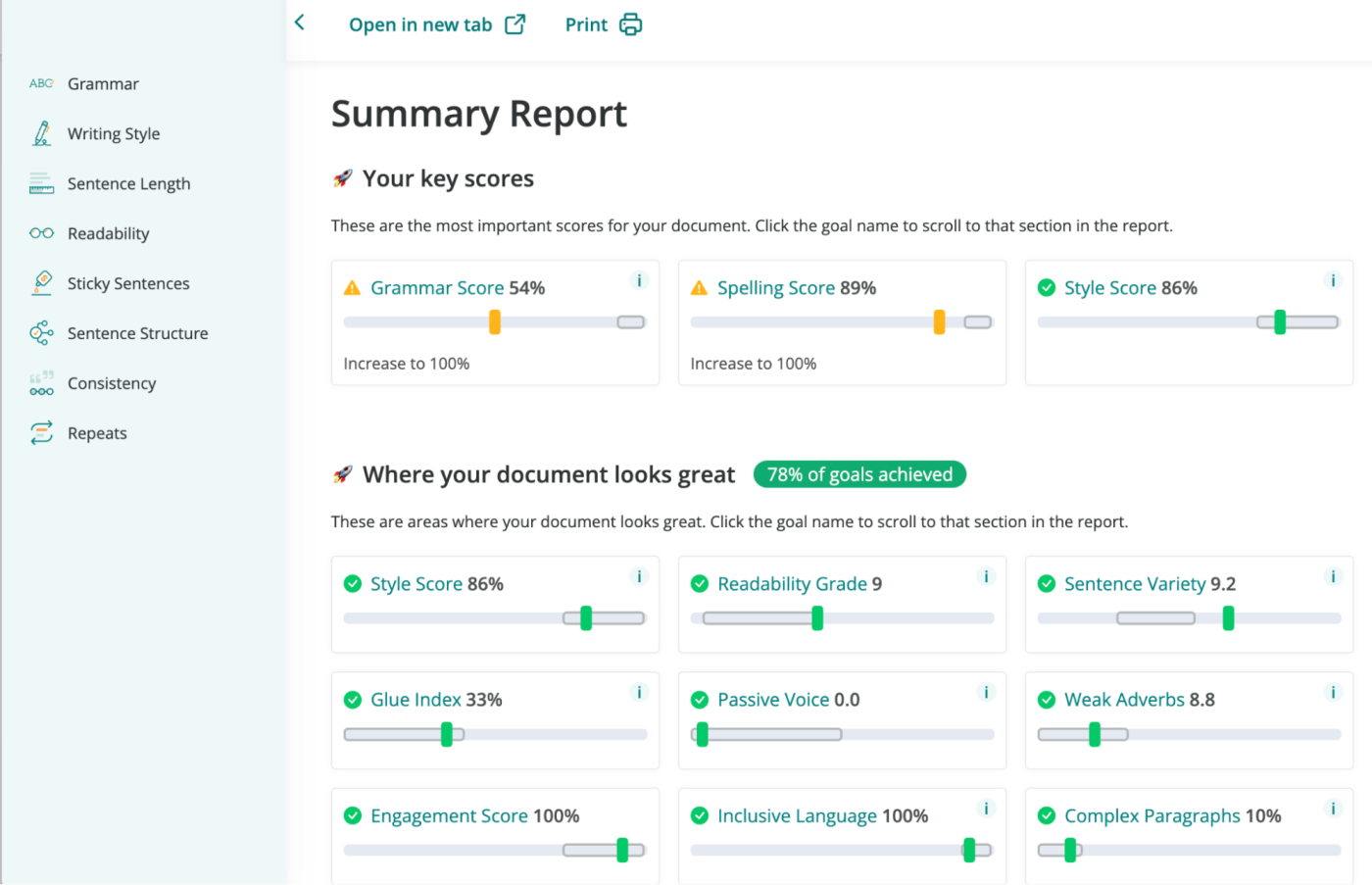
You can get reports on almost every aspect of your writing. Things like:
Repetition
Vague wording
Sentence length variation
Over-dependence on adverbs
Passive voice
Over-complicated sentence constructions
… and many more. Just take a peek at the screenshot above.
The idea here is that you'll become more aware of the mistakes that you make and be able to take steps to fix those problems and become a better writer—it's like having a real-life writing coach working beside you.
For example, you can use the Sentence Length Check report to see where you have lots of long sentences—or too many sentences around the same length. Then take steps to vary the sentence length throughout your document and keep readers engaged.
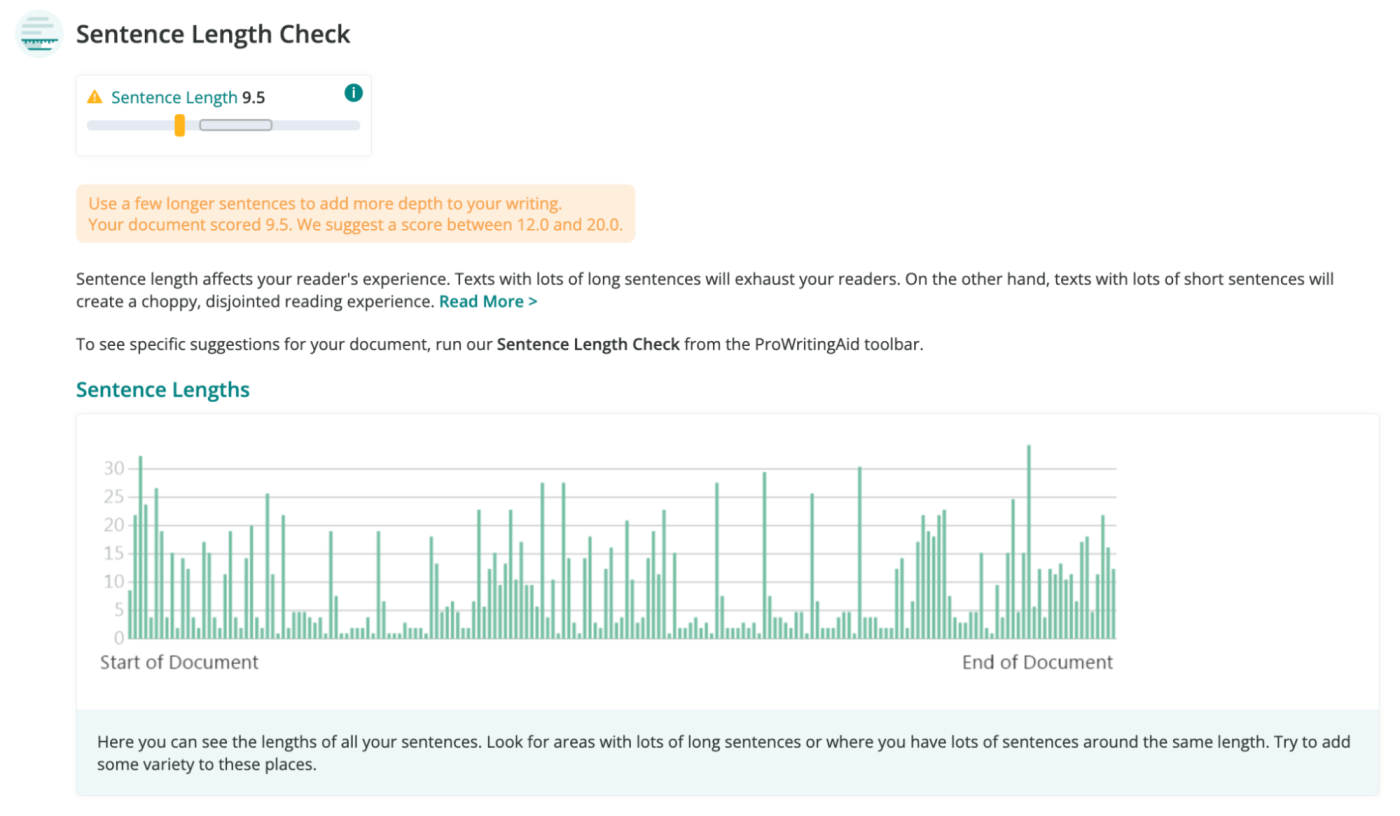
And the next time you write, hopefully you'll be thinking more about sentence length, so you can nail the report this time around.
Grammarly takes a more conservative approach. You can click on your overall performance score in the right-hand menu, and download a PDF report for further analysis, but it's nowhere near as extensive as the ProWritingAid reports.
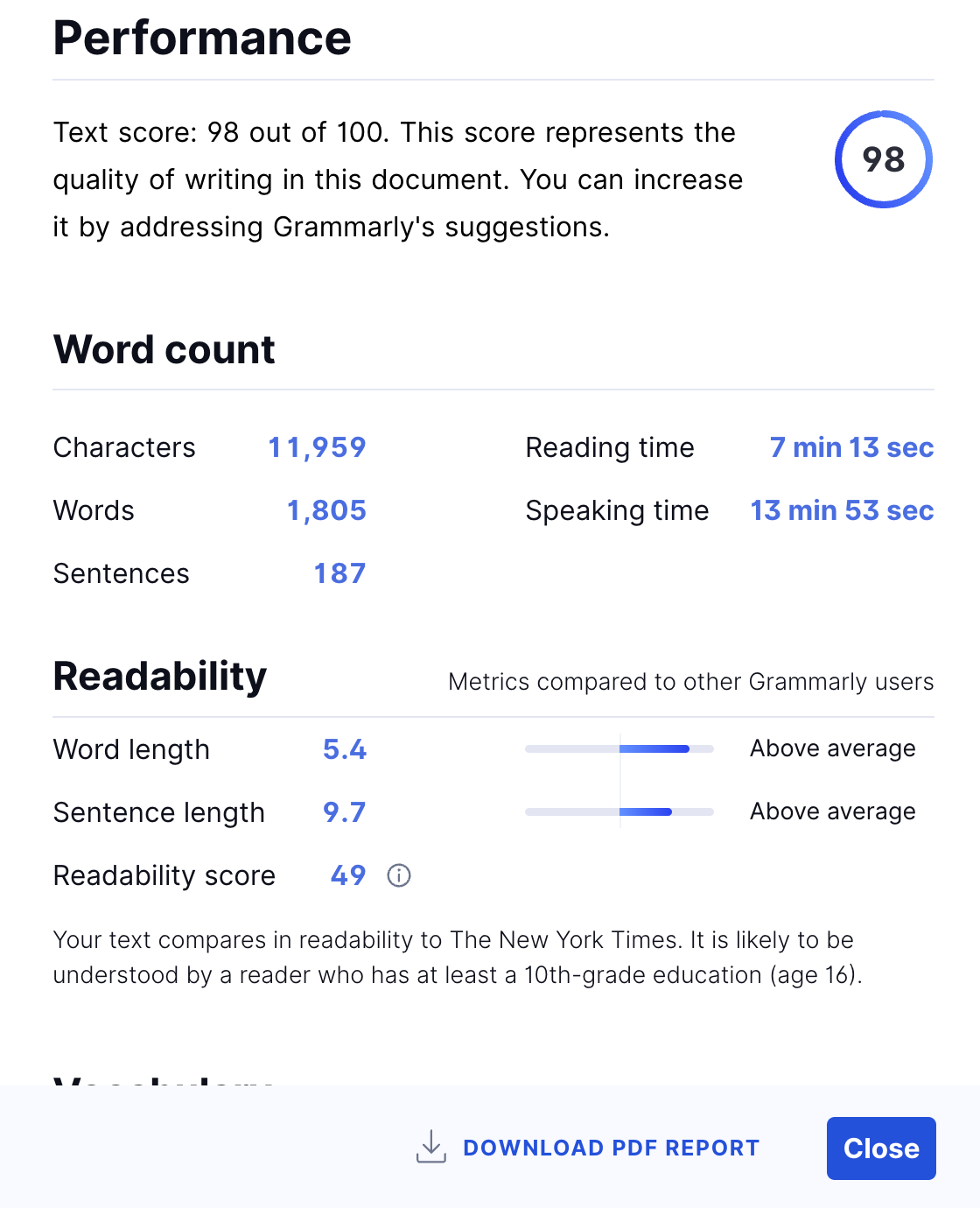
Grammarly has better generative AI
Both apps have built-in generative AI tools to help you improve your writing—through rephrasing, rewording, or rewriting—and inspire new ideas.
In the Grammarly editor, you can highlight your text and "improve" it or "rewrite" it. The default Improve option rephrases the text:

But there, you can also select to shorten it, make it more descriptive, detailed, casual, or assertive, and many more variations, which you can see in the screenshot below.
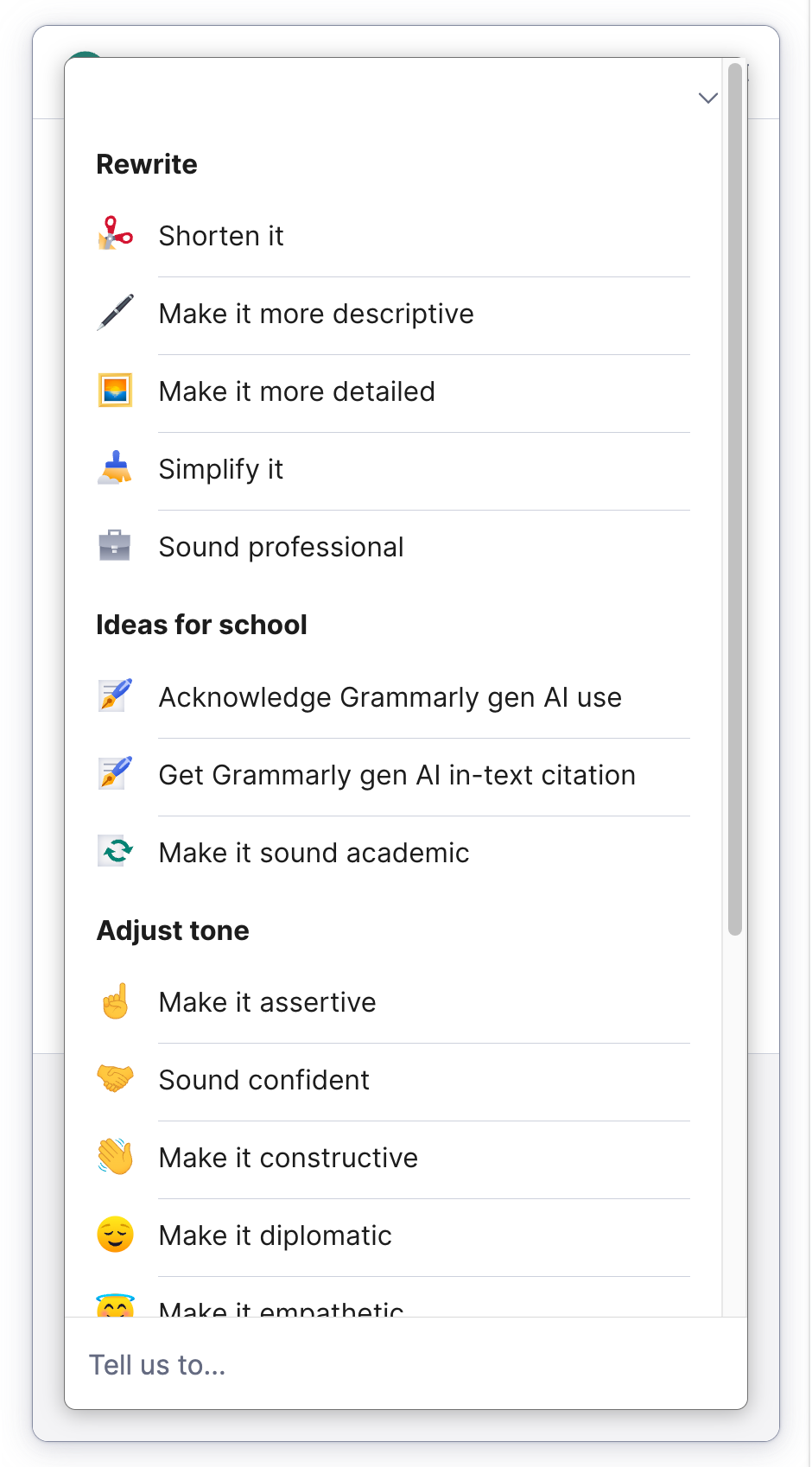
The Rewrite option goes a little deeper. First, you can set your voice:

Then you can write your own prompt or choose from a bunch of categorized options:
Rewrite: improve it, shorten it, clean up notes, make it informative, etc.
Write: create an outline, create a TL;DR, turn bullets to prose, etc.
Evaluate: pick out my main point, identify any gaps, etc.
Ideate: surprise me!
Adjust tone: sound anticipatory, sound compassionate, make it diplomatic, etc.
School: suggest cuts, suggest counterarguments, give me a research plan. etc.
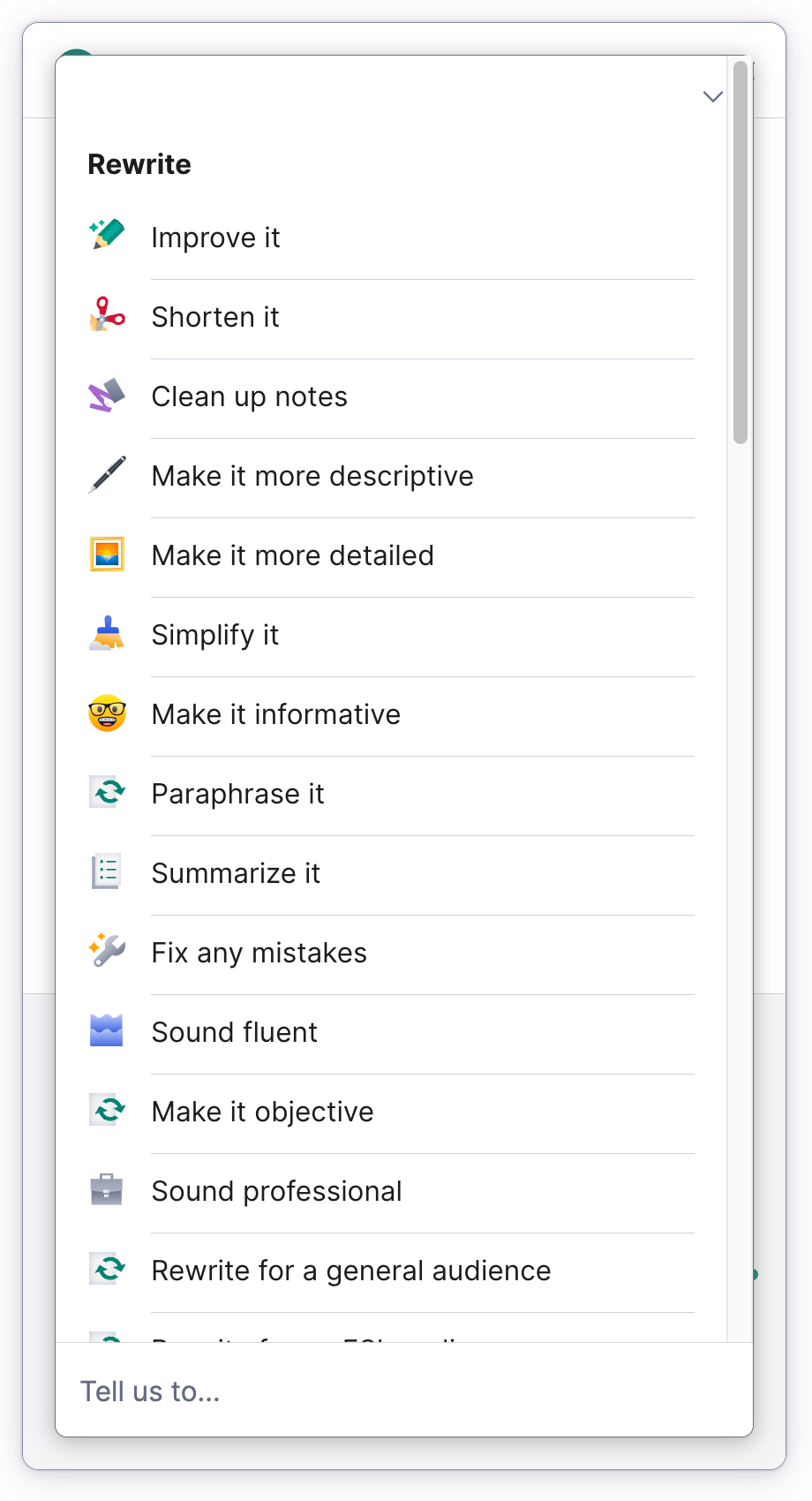
ProWritingAid, on the other hand, has three generative AI options: the Rephrase tool, AI Sparks, and the Critique Report.
If you select the Rephrase tool from the top menu, it underlines every sentence that can be rephrased—100% in this example—and you choose which sentence you want to tackle.

(To me, that looks a little overwhelming. In effect, it's offering to rewrite the entire document. Imagine if you had a 50,000-word novel to trawl through!)
When you select a sentence, ProWritingAid suggests three "standard" alternatives. But you can choose from seven different rephrasing options: standard, fluency, formal, informal, sensory, shorten, and lengthen.
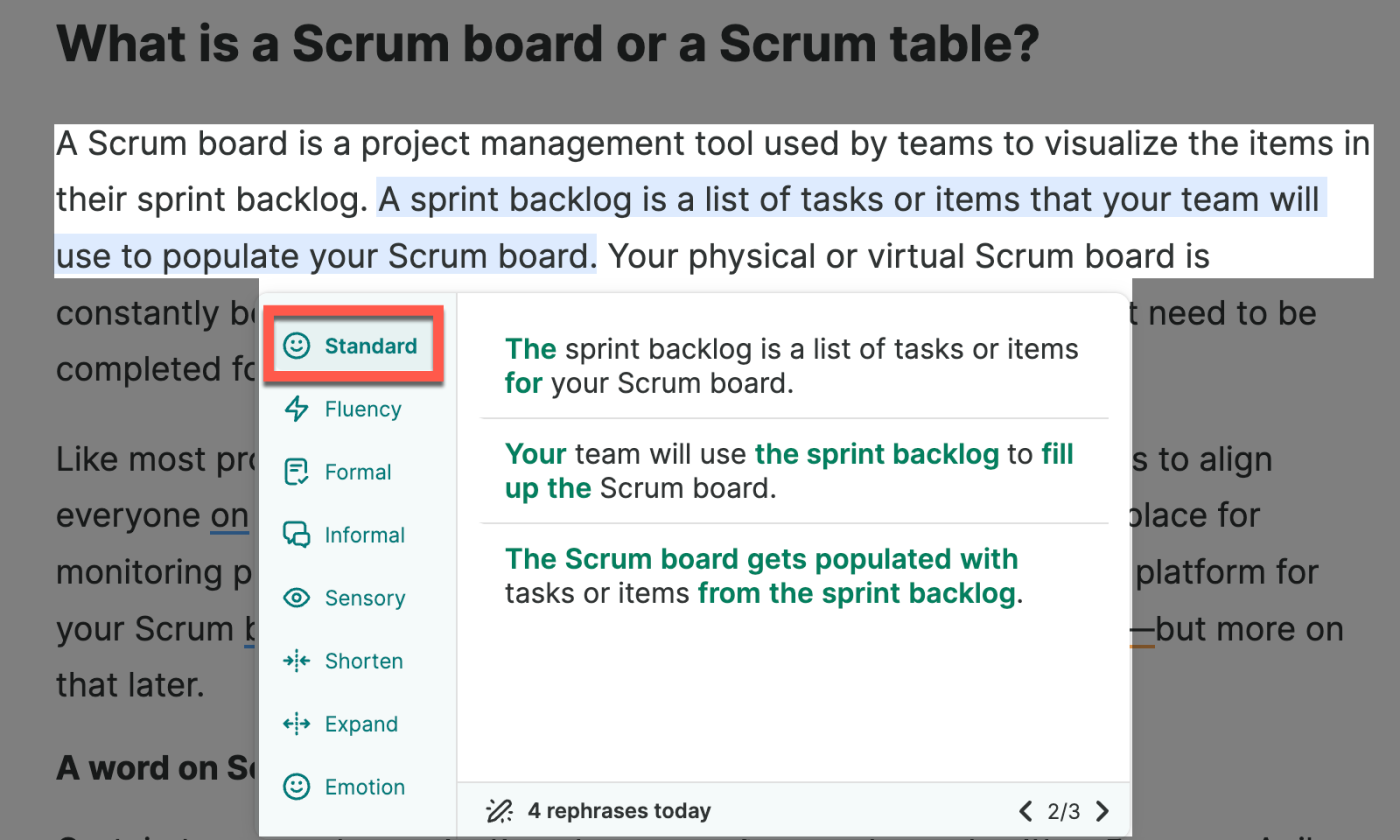
AI Sparks generates ideas to help you edit or continue writing.
In Edit mode, you get 10 options: readability, fluency, transitions, sensory, summarize, expand from notes, make 1st person, make 3rd person, past tense, and present tense.
In Continue mode, you get 13 options: continue writing, action, dialogue, emotion detail, sensory detail, analogy, counterargument, definition, emphasize, example, explanation, joke, and quote.
For example, if you choose "sensory detail" in Continue mode, AI Sparks continues your writing with a description of the sights, sounds, smells, and feelings:

ProWritingAid also has a new AI feature (currently in beta mode) called the Critique Report that gives you a custom story critique. It's like asking a developmental editor to give you feedback on key elements in your chapter, like plot, characters, style, voice, structure, and pacing. It's aimed primarily at creative writers working on novels, but I ran it on a blog article to see what it looked like, and it provided relevant feedback:
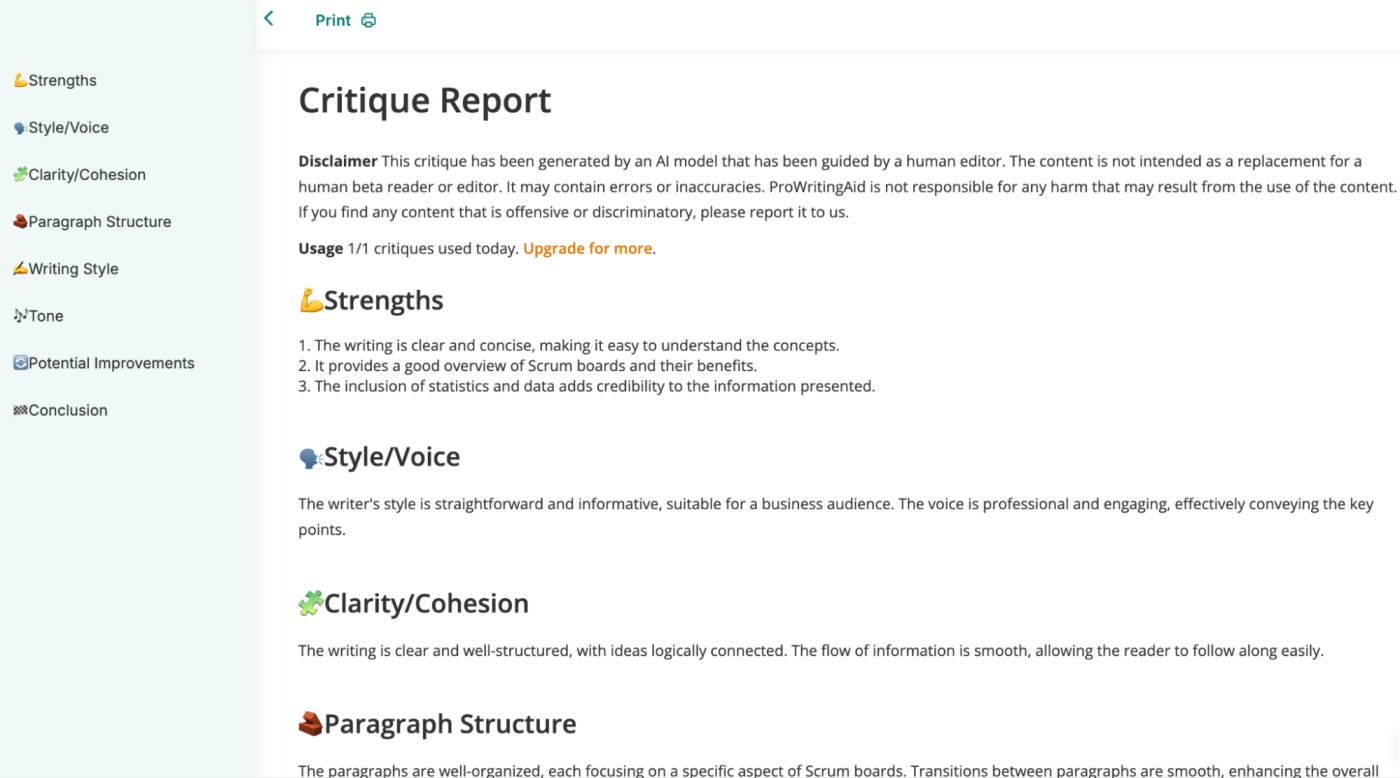
The downside to ProWritingAid's generative AI tools is the usage restrictions—even on paid plans, you're restricted to a maximum of 50 AI Sparks per day. So overall, I'd say Grammarly's generative AI tools are less restrictive and more beneficial and practical than ProWritingAid's. (And you get more bang for your buck, which I'll get to in a bit.)
Both apps integrate well with other platforms
Although neither app integrates directly with Zapier, both work with other tools through multiple desktop and mobile platforms, web browsers, apps, and plugins.
Depending on your writing needs, there's definitely a case for using the integrations over the standard editors. For example, checking and enhancing an email or social media post with the browser extension is much quicker than copying and pasting text into the main app editor.
Grammarly works across 500,000+ apps, websites, browsers, and devices, checking grammar, spelling, punctuation, clarity, conciseness, and adjusting tone.
Grammarly for Mac and Windows works on apps, word processors, email clients, and social media platforms, including Gmail, Outlook, Mail, Teams, Word, Notion, LinkedIn, Slack, Discord, and Salesforce. It also works in some browser apps, such as Gmail, but not Google Docs.
Grammarly browser extensions for Chrome, Safari, Firefox, and Edge provide real-time writing suggestions on Gmail, Google Docs, Twitter, LinkedIn, and everywhere else you write online.
Grammarly Keyboard integrates with your iOS and Android mobile apps to improve tone and eliminate mistakes in every email, message, and post you write.
ProWritingAid doesn't have a mobile app, but it does work with thousands of tools.
ProWritingAid Everywhere for Windows and Mac provides suggestions for numerous desktop apps, including Outlook, Word, PowerPoint, Mail, Pages, Evernote, LibreOffice Writer, Scrivener, Slite, Slack, Discord, and WhatsApp.
ProWritingAid browser extensions for Chrome, Safari, Firefox, and Edge provide real-time spelling and grammar checks in Gmail, Google Docs, WhatsApp, and more.
Note: The Google Docs add-in works better than the browser extension.
Both apps provide an API, so developers can bring real-time writing support to their software.
Grammarly has a more generous free plan (its paid plans are pricier but include a plagiarism checker)
At first glance, ProWritingAid's pricing plans appear more competitive, but there's a twist in the tale. Here's the score:
Both apps offer a free version that provides basic writing suggestions. ProWritingAid restricts usage to 500 words, 10 rephrases, and 3 AI Sparks per day, while Grammarly has no restrictions and also includes tone detection and 100 AI prompts per month.
For serious editing, you need the premium plans, and ProWritingAid has some great options. Although both apps start at $30/month, ProWritingAid Premium has attractive $120/year or $399/lifetime packages with unlimited rephrases and 5 AI Sparks per day. (If you want more AI functionality, you can upgrade to Premium Pro at $36/month, $144/year, or $699/lifetime and get 50 AI Sparks per day.) Grammarly Premium is pricier at $60/quarter or $144/year but includes 1,000 AI prompts per month.
But bear in mind that Grammarly's paid plans already include a plagiarism checker. Whereas with ProWritingAid, you'll need to purchase plagiarism checks as an add-on starting from $10 for 10 checks.
Suppose you want team plans for your business. In that case, Grammarly is slightly more expensive at $15/member/month (minimum 3 members) than ProWritingAid at $12/user/month (minimum 2 users). Both apps offer licenses for academic institutions, and individual students can also get 20% off ProWritingAid.
Grammarly vs. ProWritingAid: Which should you use?
After spending significant time testing Grammarly and ProWritingAid, I can confidently say that both of these apps are excellent—it's just a case of deciding which one meets your requirements.
Choose Grammarly if you want to:
Work in a less-cluttered interface
Generate better (and more) AI content
Integrate with more apps, including mobile
Choose ProWritingAid if you want to:
Analyze more comprehensive writing reports
Take advantage of better pricing options, including lifetime deals and student discounts
Receive more granular, rigorous suggestions
I can see the appeal of both apps, and there's a case for using them both to ensure you catch everything. If I were managing a team of writers or writing more academic pieces, I'd consider moving to ProWritingAid. But for now, I'm happy staying with Grammarly—I'm familiar with it, and it does what I need.
Related reading:
